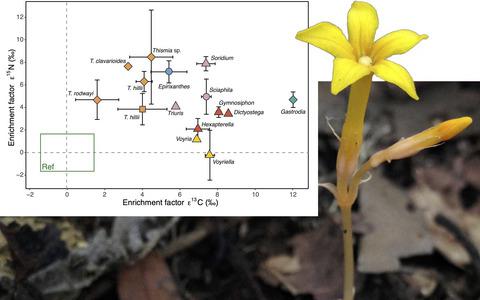Our official English website, www.x-mol.net, welcomes your feedback! (Note: you will need to create a separate account there.)
Mycoheterotrophic plants living on arbuscular mycorrhizal fungi are generally enriched in 13C, 15N and 2H isotopes
Journal of Ecology ( IF 5.5 ) Pub Date : 2020-02-28 , DOI: 10.1111/1365-2745.13381 Sofia I. F. Gomes 1 , Vincent S. F. T. Merckx 2, 3 , Judith Kehl 1 , Gerhard Gebauer 1
中文翻译:

生活在丛枝菌根真菌上的真菌异养植物通常富含13C,15N和2H同位素
更新日期:2020-02-28
Journal of Ecology ( IF 5.5 ) Pub Date : 2020-02-28 , DOI: 10.1111/1365-2745.13381 Sofia I. F. Gomes 1 , Vincent S. F. T. Merckx 2, 3 , Judith Kehl 1 , Gerhard Gebauer 1
Affiliation

|
- Fully mycoheterotrophic plants are thought to obtain carbon exclusively from their root‐associated fungal partners. The general enrichment of these plants in the heavy isotopes 13C and 15N suggests that fungi are the main nutrient source for these plants. Yet, the majority of studies have targeted mycoheterotrophic plants associated with ectomycorrhizal, orchid mycorrhizal and saprotrophic fungi, while mycoheterotrophic plants living on arbuscular mycorrhizal fungi remain understudied.
- Here, we sampled 13 species of arbuscular mycorrhizal fully mycoheterotrophic plants from five families and co‐occurring autotrophic reference plants growing in forests of tropical South America, tropical South East Asia and temperate Australasia. We measured stable isotope natural abundances (δ13C, δ15N, δ2H and δ18O), determined total nitrogen concentrations and used high‐throughput DNA sequencing to characterize the arbuscular mycorrhizal fungal communities associated with the sampled mycoheterotrophic plants.
- We observed a general enrichment in 13C and 15N isotopes across mycoheterotrophic plant families and geographic regions. We confirm cases where no 15N enrichment is present, but we show that in general arbuscular mycoheterotrophic plants are enriched in 15N. Moreover, we demonstrate for the first time that these plants are significantly enriched in 2H but not in 18O in relation to their autotrophic references. The fungal communities targeted by the mycoheterotrophs mainly consist of Glomeraceae and show strong association with the isotopic signatures and geographic origin of the plants.
- Synthesis . Our findings enlarge the limited knowledge on the multi‐element stable isotopic signatures of mycoheterotrophic plants living on arbuscular mycorrhizal fungi. We show that these plants are enriched in 13C and 2H as expected due to their mycoheterotrophic nutrition, and that in general they are also enriched in 15N, despite some exceptions. Variation in stable isotope signatures is likely influenced by plant taxonomy, geography and fungal community composition.
中文翻译:

生活在丛枝菌根真菌上的真菌异养植物通常富含13C,15N和2H同位素
- 完全异养的植物被认为仅从与根相关的真菌伴侣中获取碳。这些植物在重同位素13 C和15 N中的总体富集表明,真菌是这些植物的主要营养来源。然而,大多数研究针对的是与外生菌根,兰花菌根和腐生真菌有关的菌根营养植物,而生活在丛枝菌根真菌上的菌根营养植物仍未得到充分研究。
- 在这里,我们采样了来自五个科的丛枝菌根完全真菌异养植物,以及在热带南美,热带东南亚和温带大洋洲森林中共同存在的自养参考植物。我们测量稳定同位素丰度(δ 13 C,δ 15 N,δ 2 H和δ 18 O),确定的总的氮浓度和使用的高通量DNA测序来表征与采样mycoheterotrophic植物相关的丛枝菌根真菌的社区。
- 我们观察到了在真菌异养植物家族和地理区域中13 C和15 N同位素的普遍富集。我们确认了不存在15 N富集的情况,但是我们证明了一般丛枝菌根营养型植物富含15N。此外,我们首次证明这些植物相对于18 H富集了2 H而不是18 O他们的自养参考。真菌异养生物靶向的真菌群落主要由豆科组成,并且与植物的同位素特征和地理起源密切相关。
- 综合。我们的发现扩大了对生活在丛枝菌根真菌上的菌异养植物的多元素稳定同位素标记的认识。我们显示,由于它们的异养营养,这些植物富含13 C和2 H ,尽管有一些例外,但总体上它们还富含15N。稳定同位素特征的变化很可能受植物分类学,地理和真菌群落组成的影响。



























 京公网安备 11010802027423号
京公网安备 11010802027423号